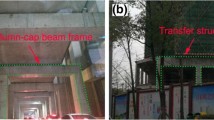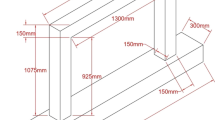Abstract
According to most of current design standards, the need for high strength and ductility of reinforced concrete frame structures is accomplished utilizing a high amount of transverse reinforcement in beam–column joints. Reinforcement congestion can be overcome by means of Fiber Reinforced Concrete and High Performance Fiber Reinforced Concrete, which are known to improve the structural performance of single structural members or beam–column joints. Through an extended numerical simulation, this paper elaborates the overall benefits of using fiber reinforced concrete materials in critical regions to the seismic behaviour of regular reinforced concrete frame structures. An extensive number of non-linear static and dynamic analyses with distributed plasticity and fibre sections are performed to compare the behaviour of simple reinforced concrete and mixed reinforced concrete/fiber reinforced concrete frames in terms of total base shear and fragility curves and failure mechanisms. Even if execution and technological aspects are beyond the scope of the present work, the use of fiber reinforced concretes in critical regions of mixed frames seems to improve the structural performance of reinforced concrete frames at a global level.





















Similar content being viewed by others
Abbreviations
- ρ :
-
Reinforcement ratio
- d c :
-
Lateral displacement of the control point (centroid of the top floor)
- f y :
-
Steel strength at yielding
- E s, E cm :
-
Moduli of elasticity of the steel and of the concrete
- b :
-
Strain-hardening ratio (ratio between post-yield and initial moduli)
- w u :
-
Maximum crack opening accepted in structural design
- CMOD 1, CMOD 3 :
-
Crack mouth opening displacements at the SLS and ULS
- l cs :
-
Characteristic length of the element
- εSLS :
-
CMOD1/lcs
- εtu :
-
Ultimate tensile strain in uniaxial tension
- R ck , f ck :
-
Characteristic values of concrete compressive strength on cubes and cylinders
- f cd, f ctd :
-
Design values of concrete strength in compression and in tension (on cylinders)
- εcu, εtu :
-
Design values of concrete ultimate strains in compression and in tension
- f yk , f yd :
-
Characteristic and design values of steel strength in tension
- εsd :
-
Design value of steel ultimate strain in tension
- K :
-
Strength amplification factor for concrete
- εc0 :
-
Design value of concrete compressive strain at the peak stress
- Z :
-
Strength reduction factor for confined concrete after the peak stress
- σc1, εc1 :
-
Design values at the first point in concrete trilinear model
- σc2, εc2 :
-
Design values at the second point in concrete trilinear model
- σc3, εc3 :
-
Design values at the third point in concrete trilinear model
- εt1, εt2 :
-
Tensile strain at zero stress, and ultimate strain in concrete trilinear model
References
Baker JW (2015) Efficient analytical fragility function fitting using dynamic structural analysis. Earthq Spectra 31(1):579–599
Bayasi Z, Gebman M (2002) Reduction of lateral reinforcement in seismic beam– column connection via application of steel fibres. ACI Struct J 99(6):772–780
Di Prisco M, Plizzari GA, Vandewalle L (2009) Fibre reinforced concrete: new design perspectives. Mater Struct 42(9):1261–1281
EN:1991-1-1:2002 Eurocode 1: general actions. densities, self-weight, imposed loads for buildings
EN:1998-1:2004 Eurocode 8: design of structures for earthquake resistance. Part 1: General rules, seismic actions and rules for buildings
Fajfar P (2000) A nonlinear analysis method for performance-based seismic design. Earthq Spectra 16(3):573–592
FEMA-356 (2000) NEHRP guidelines for the seismic rehabilitation of buildings
Filiatrault A, Pineau S, Houde J (1995) Seismic behaviour of steel-fibre reinforced concrete interior beam–column joints. ACI Struct J 92(5):543–552
Filippou FC, Popov EP, Bertero VV (1983) Effects of bond deterioration on hysteretic behavior of reinforced concrete joints. Report No. UCB/EERC-83/19
FIP MODEL CODE (2010) In: 37th conference on our world in concrete & structures
Fischer G, Li VC (2002a) Effect of matrix ductility on de-formation behavior of steel-reinforced ECC flexural members under reversed cyclic loading conditions. ACI Struct J 99(6):781–790
Fischer G, Li VC (2002b) Influence of matrix ductility on tension-stiffening behavior of steel reinforced engineered cementitious composites (ECC). ACI Struct J 99(1):104–111
Fischer G, Li VC (2003) Deformation behavior of fibre-reinforced polymer reinforced engineered cementitious composite (ECC) flexural members under reversed cyclic loading conditions. ACI Struct J 100(1):25–35
Gupta B, Kunnath SK (2000) Adaptive spectra-based pushover procedure for seismic evaluation of structures. Earthq Spectra 16(2):367–391
Henager CH (1977) Steel fibrous-ductile concrete joint for seismic-resistant structures. Publication, ACI Spec, p 53
Italian Building Code (2008) DM 14.01. 2008: Norme tecniche per le costruzioni. Italian Ministry of Infrastructures and Transportation, Rome, Italy
Jiuru T, Chaobin H, Kaijian Y, Yongcheng Y (1992) Seismic behavior and shear strength of framed joint using steel-fibre reinforced concrete. J Struct Eng 118(2):341–358
Kent DC, Park R (1971) Flexural Members with Confined Concrete. J Struct Division 97(7):1969–1990
Krawinkler H, Nassar AA (1992) Seismic design based on ductility and cumulative damage demands and capacities. Nonlinear seismic analysis and design of reinforced concrete buildings, Taylor and Francis, pp 23–39
Li VC, Wang S (2002) Flexural behaviors of glass fibre-reinforced polymer (GFRP) reinforced engineered cementitious composite beams. ACI Mater J 99(1):11–21
Menegotto M, Pinto PE (1973) Method of analysis for cyclically loaded reinforced concrete plane frames including changes in geometry and nonelastic behaviour of elements under combined normal force and bending. In: Proceedings IABSE symposium on resistance and ultimate deformability of structures acted on by well defined repeated loads, Lisbon
MIDAS/Gen (2012) Analysis manual for MIDAS/GEN. MIDAS Information Technology Co., Ltd., Seoul
Minelli F, Plizzari GA (2013) On the effectiveness of steel fibres as shear reinforcement. ACI Struct J 110(3):379–390
Mishra DK, Li VC (1995) Performance of a ductile plastic hinge design with an Engineered Cementitious composite. UMCEE Report, 95-06
Mwafy AM, Elnashai AS (2001) Static pushover versus dynamic collapse analysis of RC buildings. Eng Struct 23(5):407–424
Newmark NM, Hall WJ (1982) Earth spe des: engineering monographs on earthquake criteria, structural design, and strong motion records. Earthquake Engineering Research Institute Monograph, Berkeley, CA
Parra-Montesinos GJ, Peterfreund SW, Chao SH (2005) Highly damage-tolerant beam–column joints through use of high-performance fibre-reinforced cement composites. ACI Struct J 102(3):487–495
Priestley MJN, Paulay T (1992) Seismic design of reinforced concrete and masonry buildings. Wiley, New York
Rota M, Zuccolo E, Taverna L, Corigliano M, Lai CG, Penna A (2012) Mesozonation of the Italian territory for the definition of real spectrum-compatible accelerograms. Bull Earthq Eng 10(5):1357–1375
Scott BD, Park R, Priestley MJN (1982) Stress–strain behavior of concrete confined by overlapping hoops at low and high strain rates. ACI J Proc 79(1):13–27
Shannag MJ, Abu-Dyya N, Abu-Farsakh G (2005) Lateral load response of high performance fibre reinforced concrete beam–column joints. Constr Build Mater 19(7):500–508
Spacone E, Filippou FC, Taucer FF (1996) Fibre beam–column model for non-linear analysis of R/C frames: part I. Formulation. Earthq Eng Struct Dyn 25(7):711–726
Vasanelli E, Micelli F, Aiello MA, Plizzari G (2014) Crack width prediction of FRC beams in short and long term bending condition. Mater Struct 47(1–2):39–54
Yuan F, Pan J, Xu Z, Leung CKY (2013) A comparison of engineered cementitious composites versus normal concrete in beam–column joints under reversed cyclic loading. Mater Struct 46(1–2):145–159
Author information
Authors and Affiliations
Corresponding author
Rights and permissions
About this article
Cite this article
Candido, L., Micelli, F. Seismic behaviour of regular reinforced concrete plane frames with fiber reinforced concrete in joints. Bull Earthquake Eng 16, 4107–4132 (2018). https://doi.org/10.1007/s10518-018-0325-9
Received:
Accepted:
Published:
Issue Date:
DOI: https://doi.org/10.1007/s10518-018-0325-9




